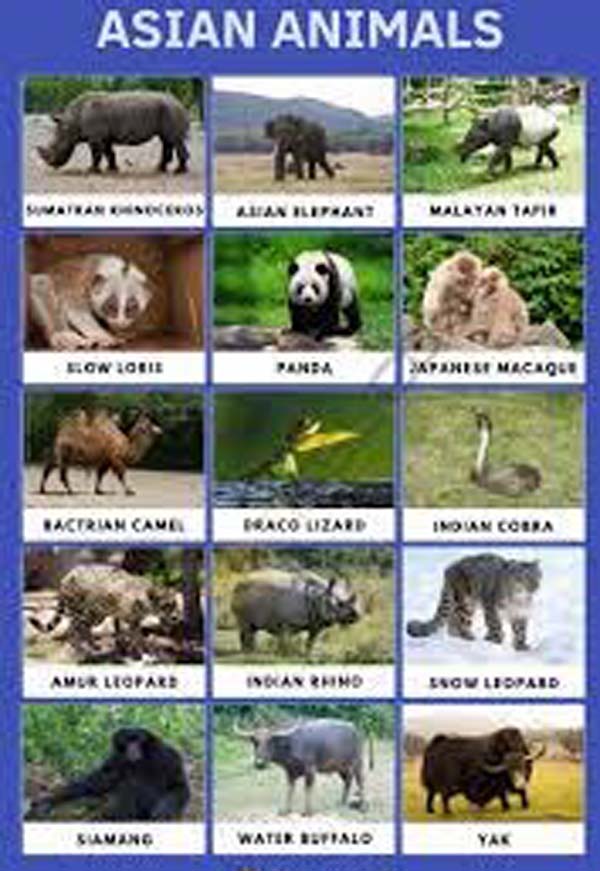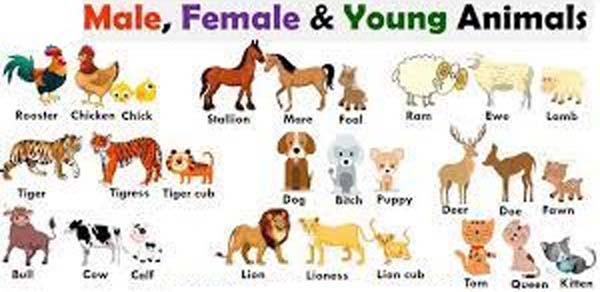Asian Animals: There are a significant number of species found on Earth, and to understand the operation of the animal kingdom, learning about Asian animals a-z is very important.
To make this job a little easier on the learner’s side, this specific article has been penned down to provide knowledge about Unique animals in Asia; and for the ease of education about some of these animal species on earth Asian animals facts have also been included in the list of Asian Animals names, for the learner’s increased convenience.
It also provides the learners interested in this topic, some extra knowledge about Central Asian animals to those who really wish to learn more about this subject.
Study the most important English Vocabulary Words identified by our experts and learn the right vocabulary to use in your day to day conversations
List of Asian Animals
Name of Asian Animals
- Amur Leopard
- Asian Elephant
- Bactrian Camel
- Draco Lizard
- Indian Cobra
- Indian Rhino
- Japanese Macaque
- Malayan Tapir
- Panda
- Siamang
- Slow Loris
- Snow Leopard
- Sumatran Rhinoceros
- Water Buffalo
- Yak
Description and Pictures on the List of Asian Animal
Amur Leopard
- We usually think of leopards as animals living in the savannas of Africa, but in the parts of Russian Far East, a rare sub-species has adapted to survival in the temperate forests that constitute the northern-most part of the species’ range.
- Like other leopards, the Amur leopard is capable of running at speeds of up to 37 miles each hour. This leopard species is incredible and has been reported to leap into air more than nineteen feet horizontally and ten feet vertically.
- The Amur leopard is an individual species. Nimble-footed and robust, it carries and hides raw kills so that other predators do not relish them. It has been observed that some males live with females after mating and may even help with bring up the young.
- Several male members sometimes follow and fight over a female to win dominance. They live for around 15 years and in can survive captivity for up to twenty years. The Amur leopard is alternatively known as the Far East leopard, the Manchurian, or the Korean leopard.
| Kingdom | Animalia |
| Phylum | Chordata |
| Class | Mammalia |
| Order | Carnivora |
| Family | Felidae |
| Genus | Panthera |
| Scientific Name | Panthera pardus orientalis |
Asian Elephant
- The Asian elephant is reportedly the largest land mammal on the Asian continental plate. This species inhabits dry or wet forests and grassland habitats in thirteen wide range of countries spanning across South and South-eastern Asia.
- They have preferred forage plants for consumption, Asian elephants have adapted to surviving on resources that diversify based on the region.
- Asian elephants are highly sociable animals, forming six to seven related females that the dowager leads the oldest female. Similar to African elephants, these groups from time-to-time join others to form larger herds, although the species’ associations are relatively short-lived.
- In the Asian continent, elephant herd sizes are quite smaller than those of the savannah elephant species in Africa.
- Almost more than two-thirds of an elephant’s day may is seen to be spent feeding on grass or plants, but it the species also eats large amounts of tree bark, roots, leaves, and trim stems.
- Some cultivated crops such as bananas, sugarcane, and rice are favorite food of this species. Elephants are always settled close to a source of freshwater because they need to drink at least once each day.
| Kingdom | Animalia |
| Phylum | Chordata |
| Class | Mammalia |
| Order | Proboscidea |
| Family | Elephantidae |
| Genus | Elephas |
| Scientific name | Elephas maximus |
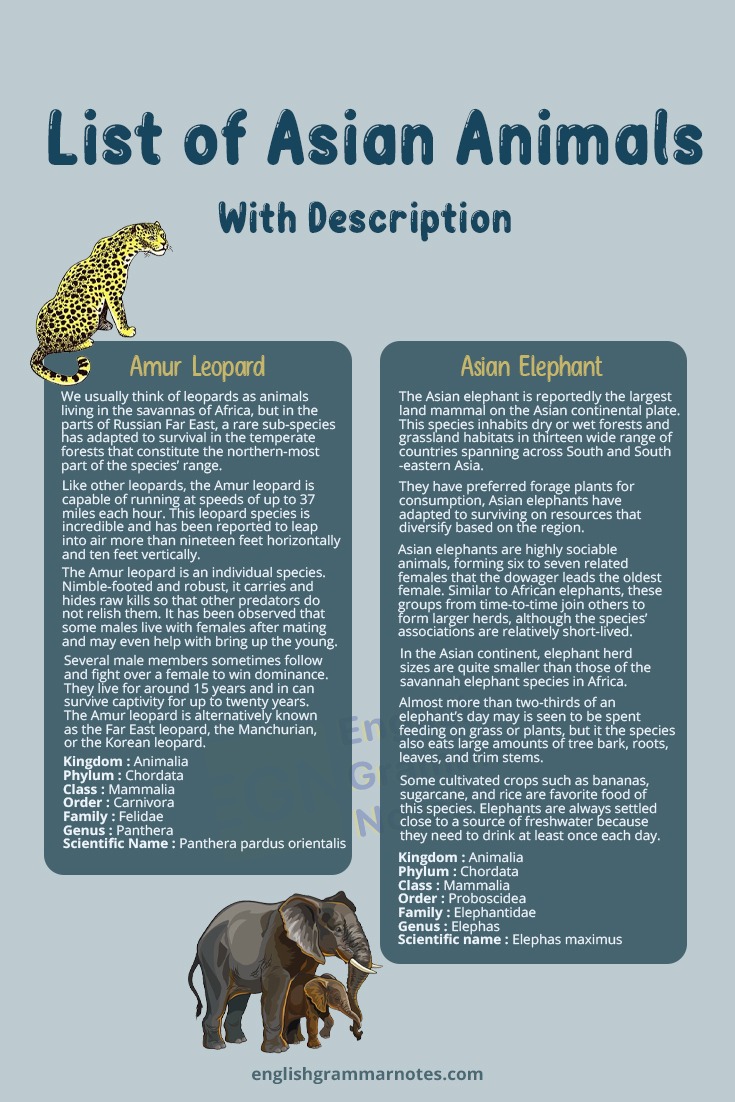
Bactrian Camel
- The Bactrian Camel is a tough and strong animal and it can withstand drought, food shortages, and even the radiation from nuclear weapons testing, which makes this species quite unique.
- This species is greatly adapted to life in the harsh Gobi Desert region, which is one of the most fragile regions on this planet. They are a group of solitary land mammals who are capable of drinking brackish or salty water without any ill effects on their health.
- The fat which is stored in their humps enable these camels to go without eating or drinking for several days at a time. Hence, upon finding water, they do drink vast quantities rapidly to replace the missing water from their bodies.
- The Bactrian Camel is known as the probable ancestor of all other domestic two-humped camel species. Camelids, the name of the family they belong to, had evolved in North America over a span of 46 million years in the past.
- With camels migrating and spreading rapidly through Asia and becoming extinct in their ancestral ranges in the American Continent, the fact can be proved.
- The Bactrian camel differs from all other hoofed mammals in the stature of their body where the load rests not on the hooves but on the sole pads, and only the front end of the hooves comes in contact with the ground.
- Lesser than a thousand individual camels of this kind survive today, in only four locations; and due to hunting, competition for resources with introduced livestock, and habitat loss, they continue to be threatened by killing animals.
| Kingdom | Animalia |
| Phylum | Chordata |
| Class | Mammalia |
| Order | Artiodactyla |
| Family | Camelidae |
| Genus | Camelus |
| Scientific name | Camelus bactrianus |
Draco Lizard
- Draco Lizard belongs to the genus of the lizard family of Agamidae. They are members of the Draco genus are commonly known as flying lizards because of the scaly membranes between the front legs and hind legs which allow them to glide from one tree tree to the next.
- There are more than forty species of the Draco lizard. Most species are smaller, with a snout-vent which is at a length less than 8 cm, and occurs in the forests of South-eastern Asia and the East Indies.
- The Draco species are usually dull and not brightly coloured, although their wing flaps can be brightly colored with black spots on orange wings. The membranes are supported by their ribs that grow away from the body.
- At resting position, the ribs and membranes curl against the sides of the body. To glide with ease, these animals jump outward, spread their rib wings or flaps, and drift to a downward position.
- A low-angle glide can carry the lizard as far as 50 meters or about 160 feet, to another tree or the ground.
| Kingdom | Animalia |
| Phylum | Chordata |
| Class | Reptilia |
| Order | Squamata |
| Family | Agamidae |
| Genus | Draco |
| Scientific Name | Draco volans |
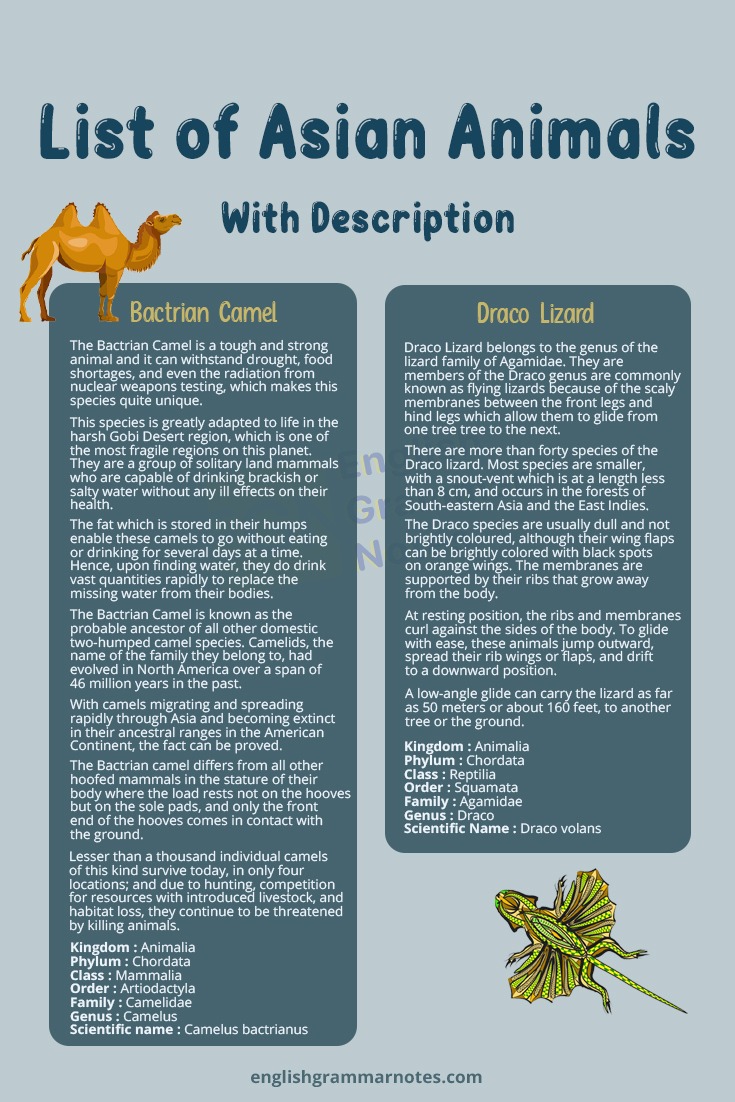
Indian Cobra
- The Indian cobra is a significantly large, highly venomous snake and it is a member of the ‘big four’ snake species that inflict the most snakebites on humans in the Indian subcontinent.
- The Indian cobra is greatly mentioned in Indian mythology and culture and is often seen as a partner of most snake charmers.
- These snakes usually vary tremendously in color and pattern throughout their range in the swampy or forested regions.
- The ventral scales or the underside of the snake has a coloration of various colours such as grey, yellow, tanned, brownish, reddish, or black. The dorsal scales can have a hood mark or color patterns but it is not always observed.
- The snakes have salt-and-pepper speckles, that are especially observed in adult species, and are seen on the dorsal scales.
- The Indian cobras can easily be distinguished by their relatively large and quite majestic hood, that expands outward when threatened. Many specimens also seen to exhibit a hood mark, which is located at the rear portion of the Indian cobra’s hood.
- When the hood mark is present, are two circular ocelli patterns united by a curved line, evoking the image of spectacles.
| Kingdom | Animalia |
| Phylum | Chordata |
| Class | Reptilia |
| Order | Squamata |
| Family | Elapidae |
| Genus | Naja |
| Scientific Name | Naja naja |
Indian Rhino
- The Indian rhinoceros alternatively known as the Indian Rhino is the biggest of the three great rhinoceroses’ species of Asia, among which the African white rhino is the largest of all rhino species.
- It has a single black horn that identifies it and a greyish to brownish hide and skin fold, that gives it an armour-plated look.
- This rhino species is a conservational success by successive efforts of the government, as its numbers have progressed significantly since the 1975’s.
- Before this time, just 600 rhinos were seen to be living in the wild, and following decades of controlled and planned efforts, their numbers increased to 3,500 total, in Nepal and India by the middle of 2015. At present, it is the most diverse out of the three rhino species found in Asia.
| Kingdom | Animalia |
| Phylum | Chordata |
| Class | Mammalia |
| Order | Perissodactyla |
| Family | Rhinocerotidae |
| Genus | Rhinoceros |
| Scientific Name | Rhinoceros unicornis |

Japanese Macaque
- The Japanese macaque is a unique monkey of medium size as compared to other monkey species. They are alternatively called the snow monkey species because they often are seen to live in snowy regions.
- The Japanese Macaque has long, thick fur cost, of a brownish or grey color, throughout their bodies. The dense fur has a contrasting difference as compared to their faces, which have naked peachy skin. The rump of this monkey species is observed to be red in adults.
- The males of the species is significantly larger than the females. Macaques have long whiskers on their faces and a beard. Their tail is quite short.
- In comparison to the other monkey species, the macaque has opposable thumbs, that enable it to get a good hold of things. This species walks on its hind legs while holding something in its hands.
| Kingdom | Animalia |
| Phylum | Chordata |
| Class | Mammalia |
| Order | Primates |
| Family | Cercopithecidae |
| Genus | Macaca |
| Scientific Name | Macaca fuscata |
Malayan Tapir
- Malayan tapir which is otherwise known as the Asian tapir is the single living species of pre-existing Old World tapir. There are only four tapir species around the world, and this animal is the most sizable among them.
- Meanwhile, the Asian tapir is among the most evolutionarily and unique tapir species in the world.
- This mammal is quite shy and introverted by nature, and mostly lived in hiding from human disturbance in interior areas of their natural forest habitats. Hence, the animal is very difficult to come across or spot in the wild.
- Along with the other tapir species, it is seen to possess an elongated, and fleshy nose, which can be used to grasp objects such as leaves and put them into the mouth.
- The Malayan tapir has a highly-developed and boosted sense of smell. This animal species is an odd-toed ungulate or has hooves and displays three toes on each of its hind feet. The Malayan Tapir species has a distinctive black and white coloration.
| Kingdom | Animalia |
| Phylum | Chordata |
| Class | Mammalia |
| Order | Perissodactyla |
| Family | Tapiridae |
| Genus | Acrocodia |
| Species | A. indica |
| Binomial name | Acrocodia indica |
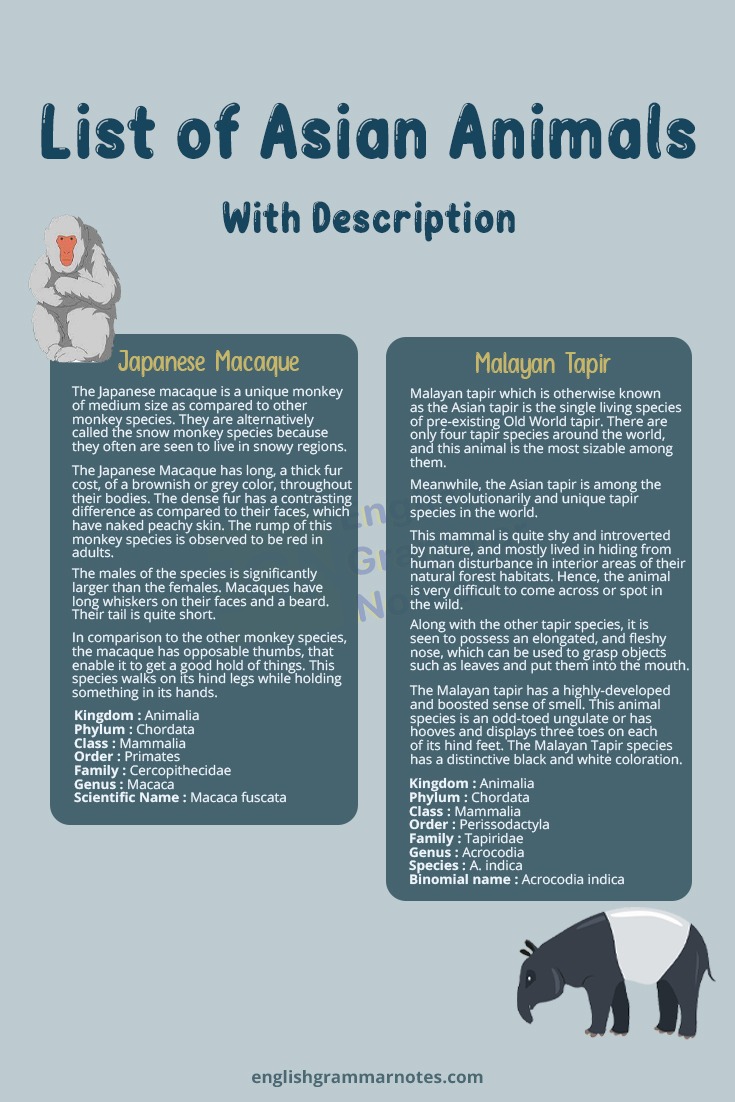
Giant Panda
- The Giant panda is a unique bear of medium to large size with a larger head as compared to other panda species. They have small eyes, a long muzzle, wide nose, and a short tail. This species has a very enhances sense of smell.
- The species has large jaws with strong muscles in them, and together with its flat molars, they are able to grind bamboo leaves and stems for consumption.
- Its thick fur is creamy to whitish in colour with big black patches on their shoulders, ears, and nose areas, with characteristic black patches around their eyes.
- An expansion of its wrist bone, which serves as a normal thumb, permits them to grip the bamboo stems.
| Kingdom | Animalia |
| Phylum | Chordata |
| Class | Mammalia |
| Order | Carnivora |
| Suborder | Caniformia |
| Family | Ursidae |
| Genus | Ailuropoda |
| Scientific Name | Ailuropoda melanoleuca |
Siamang
- This is the largest of Siamang gibbon species, which are sometimes also known as the ‘lesser ape species.’ The Siamang gibbons are known widely for their graceful movements, hopping from tree to tree and their impressive emotive calls.
- This species sometimes grows to its double in size as compared to other gibbons. The Siamang gibbons have shaggy black fur all over, except for a gray patch around their chin and mouth area.
- The infants of this kind are entirely black. Males and females of the species are alike in appearance. Their sizeable exposed throat sac acts as a resonator for extremely loud, deep, and powerful sounds.
| Kingdom | Animalia |
| Phylum | Chordata |
| Subphylum | Vertebrata |
| Class | Mammalia |
| Order | Primates |
| Family | Hylobatidae |
| Genus | Symphalangus |
| Scientific Name | Symphalangus syndactylus |
Slow Loris
- The Sunda slow loris is a venomous arboreal primate which is native to Southeast Asia. Similar to other slow loris species, it has a wet nose known as rhinarium, a round head, small ears that are hidden in thick fur, a flattened face, large eyes, and a vestigial tail in their anatomy.
- The Sunda slow loris or Snow Loris has dark rims around its wide eyes, a white nose with a whitish stripe that extends up to the forehead region, and a dark strip that expands from the back of their head along the spine.
- It has soft, thick, woolly fur that ranges from light brownish to deep reddish-brown, with a lighter base.
| Kingdom | Animalia |
| Phylum | Chordata |
| Class | Mammalia |
| Order | Primates |
| Family | Lorisidae |
| Genus | Nycticebus |
| Scientific Name | Nycticebus coucang |
White Leopard
- This unique leopard species has a white furry coat with yellow or brownish tinges and is it covered with rings of brownish or black spots or patterns. The markings help them with camouflaging themselves from prey.
- Their fur is woolly and long and allows protection from extreme cold weather conditions. Their tails have a heavy coat of fur, and the undersides of their paws also have a significant amount of fur to protect them against cold snow.
- They have rounded heads that has small ears, and their heavy brow is distinctive, with the head being small as compared to the rest of the body size.
- Their long tail helps the leopard to balance as it travels over rough and frequently snowy terrain. Its mighty limbs are relatively short for its body size, and the species is known to have large and powerful paws.
| Kingdom | Animalia |
| Phylum | Chordata |
| Class | Mammalia |
| Order | Carnivora |
| Family | Felidae |
| Genus | Panthera |
| Scientific Name | Uncia uncia |
Sumatran Rhino
A Sumatran rhinoceros is reportedly the smallest amongst all the living rhino species and the only single one of Asian rhinos which has two horns.
The species has a shaggy appearance and it is their best-known feature, due to the long, coarse hair that covers much of its body, almost all of the skin. As the rhino grows older, the thick hair falls out, which indicated that its age can, to a certain extent, be understood or observed by how hairy the rhino is.
Underneath the belly, its hide has a reddish undertone, making this rhino unique in appearance as compared to any other rhino. Its hairiness is interests to many scientists to conclude that it may be a direct descendant of the woolly rhinoceros, which have gone extinct for about ten thousand years.
The Sumatran rhinos, along with the Javan rhino, are among the most threatened rhino species in the world, currently. Sumatran rhinos are seen to outnumber the Javan rhinos, but are observed as more under threat by poaching. They had been declared extinct in Malaysia in 2015.
| Kingdom | Animalia |
| Phylum | Chordata |
| Class | Mammalia |
| Order | Perissodactyla |
| Family | Rhinocerotidae |
| Genus | Dicerorhinus |
| Scientific Name | Dicerorhinus sumatrensis |
Wild Asian Buffalo
- Asian Wild water buffalo which are alternatively known as the Wild Asian Buffalo are animals of huge size with a large, rounded chest area and rather shorter legs compared to some of its other species.
- Females of this kind are noticeably smaller than male buffalos. These buffalos have smaller ears, that are drooping downwards; and they have fluffy tips or tufts on their tails and wide, outspread hooves.
- The Wild Asian Buffalo species has horns that are curved and outstretched upwards. Horns of females are significantly longer than those of males. While the horns of males are much thicker than those of the females.
- Both the females and males of this species are black to slate or greyish while mature males are distinguished by rather darker color. The buffalo have light-coloured lower legs and white specks of half-roundish pattern on the upper chest are and their throat.
- In extension, sometimes a bunch of faint light-coloured spots around the eyes mouth and noses of this species can be observed.
| Kingdom | Animalia |
| Phylum | Chordata |
| Class | Mammalia |
| Order | Artiodactyla |
| Family | Bovidae |
| Genus | Bubalus |
| Scientific Name | Bubalus arnee |
Wild Yak
- The Wild yak is a significantly larger wild bovidae which is native to the Himalayan region. This species is among the largest bovids and are subordinate only to the gaur species of yak in shoulder height.
- The Wild yak is also the largest native animal surviving in their range. These yaks are heavily built animals with a bulky and robust frame. It has sturdy legs, and blunt, rounded cloven hooves.
- Both sexes of this species have long shaggy hair with a dense and thick woolly undercoat over the chest area, flanks, and thighs for insulation against the cold weather.
- In males of this species especially, their undercoat may form a long skirt-like structure that can reach the ground.
- The tails of the wild yak species is quite long and almost horse-like. The coat is generally black or dark brownish and covers most of the animal’s body, with a grey muzzle, although the appearance of some wild golden to brownish individuals have been recorded over the years.
- Wild yaks with gold-coloured hair are identified as the Wild Golden yak.
| Kingdom | Animalia |
| Phylum | Chordata |
| Class | Mammalia |
| Order | Artiodactyla |
| Family | Bovidae |
| Genus | Bos |
| Scientific Name | Bos mutus |

